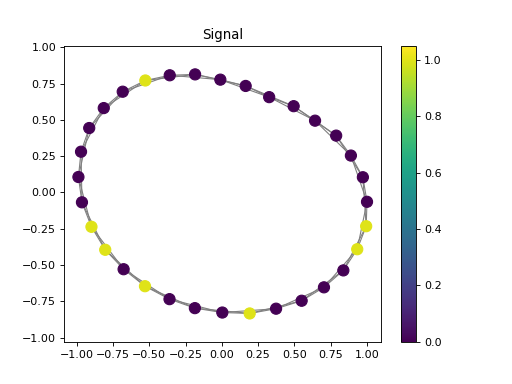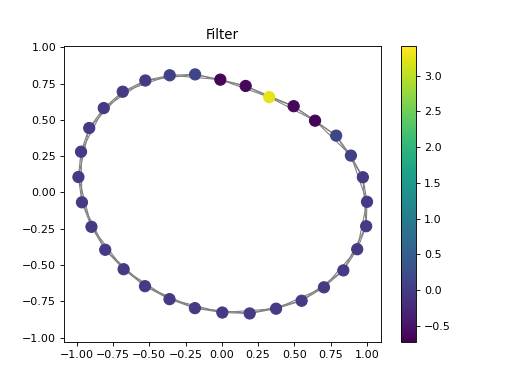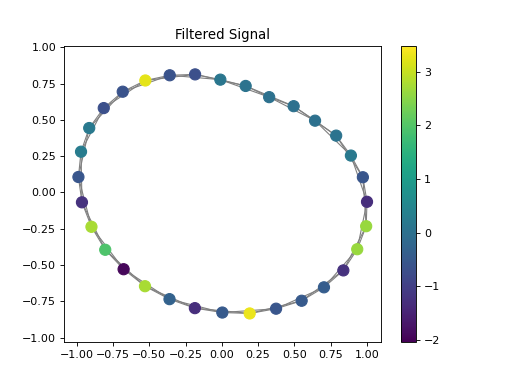Convolution Operators¶
Module: pycgsp.linop.conv
Base class for graph convolution operators.
Graph convolution operator.
|
Graph convolution. |
-
class
GraphConvolution(Graph: pygsp.graphs.graph.Graph, coefficients: Union[numpy.ndarray, list, tuple])[source]¶ Bases:
pycsou.linop.base.PolynomialLinearOperatorGraph convolution.
Convolve a signal \(\mathbf{u}\in\mathbb{C}^N\) defined on a graph with a polynomial filter \(\mathbf{D}:\mathbb{C}^N\rightarrow \mathbb{C}^N\) of the form:
\[\mathbf{D}=\sum_{k=0}^K \theta_k \mathbf{L}^k,\]where \(\mathbf{L}:\mathbb{C}^N\rightarrow \mathbb{C}^N\) is the normalised graph Laplacian (see [FuncSphere] Section 2.3 of Chapter 6).
Examples
>>> G = RandomRegular(seed=0) >>> G.compute_laplacian(lap_type='normalized') >>> signal = np.random.binomial(n=1,p=0.2,size=G.N) >>> coefficients = np.ones(shape=(3,)) >>> ConvOp = GraphConvolution(Graph=G, coefficients=coefficients) >>> filtered = ConvOp * signal
import numpy as np from pygsp.graphs import Ring from pycgsp.linop.conv import GraphConvolution np.random.seed(0) G = Ring(N=32, k=2) G.compute_laplacian(lap_type='normalized') G.set_coordinates(kind='spring') signal = np.random.binomial(n=1,p=0.2,size=G.N) coefficients = np.ones(3) ConvOp = GraphConvolution(Graph=G, coefficients=coefficients) e1 = np.zeros(shape=G.N) e1[0] = 1 filter = ConvOp * e1 filtered = ConvOp * signal plt.figure() ax=plt.gca() G.plot_signal(signal, ax=ax, backend='matplotlib') plt.title('Signal') plt.axis('equal') plt.figure() ax=plt.gca() G.plot_signal(filter, ax=ax, backend='matplotlib') plt.title('Filter') plt.axis('equal') plt.figure() ax=plt.gca() G.plot_signal(filtered, ax=ax, backend='matplotlib') plt.title('Filtered Signal') plt.axis('equal')
Notes
The
GraphConvolutionoperator is self-adjoint and operates in a matrix-free fashion, as described in Section 4.3, Chapter 7 of [FuncSphere].See also
-
__init__(Graph: pygsp.graphs.graph.Graph, coefficients: Union[numpy.ndarray, list, tuple])[source]¶ - Parameters
Graph (pygsp.graphs.Graph) – Graph on which the signal is defined, with normalised Laplacian
Graph.Lprecomputed (see pygsp.graphs.Graph.compute_laplacian(lap_type=’normalized’).coefficients (Union[np.ndarray, list, tuple]) – Coefficients \(\{\theta_k, \,k=0,\ldots,K\}\subset \mathbb{C}\) of the polynomial filter.
dtype (type) – Type of the entries of the graph filer.
- Raises
AttributeError – If
Graph.Ldoes not exist.NotImplementedError – If
Graph.lap_typeis ‘combinatorial’.
-


